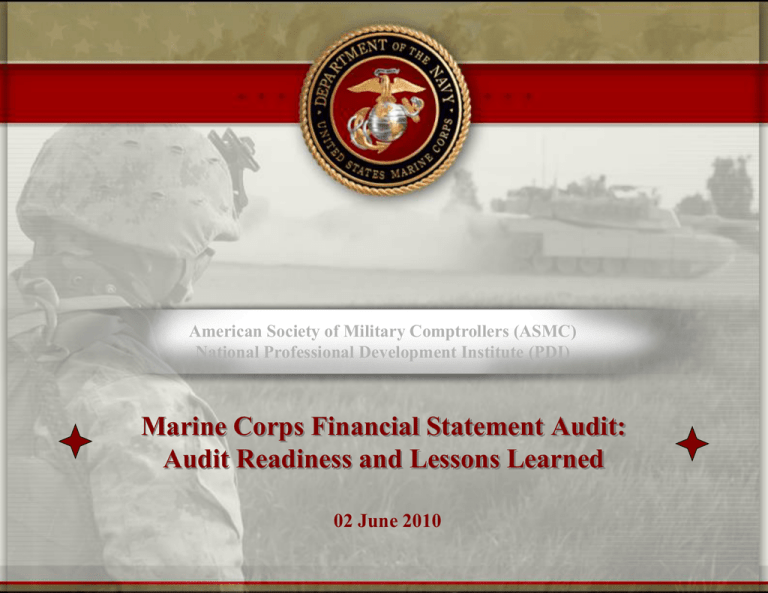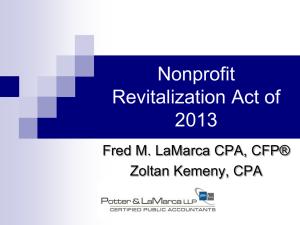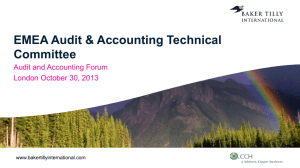Audit Readiness - American Society of Military Comptrollers
advertisement

American Society of Military Comptrollers (ASMC) National Professional Development Institute (PDI) Marine Corps Financial Statement Audit: Audit Readiness and Lessons Learned 02 June 2010 Achieving Audit Readiness: “Doing Business the Right Way” Objective: improve warfighter support through improved financial management and accounting governance and sustainability across “5 Key Strategic Areas.” Management/Internal Controls Organization & Infrastructure Policies & Procedures Information Systems People UNCLASSIFIED “The Marine Corps is a combat force-not a business. To be successful, however, we need to support warfighting excellence with wellmanaged business processes that are both effective and efficient.” General Michael W. Hagee 33rd Commandant of the Marine Corps 2 Bringing Value to the Warfighter… Through Audit Readiness Audit Readiness Results Decreased Undelivered Orders Reduced Abnormal Accounts Payable Decreased Unmatched Disbursements Decreased Interest Penalty Payments Total Investments: Total benefit: Net Present Value: $ 9.9M $27.3M $17.4M For each $1 spent on financial improvement, an estimated $2.77 in value was created for the warfighter. UNCLASSIFIED 3 Audit Readiness via Training and Testing Engaged our field commands in several audit-like tests. Implemented an aggressive Internal Control over Financial Reporting (ICOFR) program. Demonstrated that Fund Balance w/ Treasury is fully reconciled. Final Test: audit trail assessment by the Department of Defense Inspector General (DoDIG) and Financial Improvement and Audit Readiness Directorate (FIAR). UNCLASSIFIED 4 Our Current State: Beginning Balance Testing Audit Opinion Communication IT Environment Accessibility Site Visits Audit Evidence Data Reliability Audit Phases 1. Planning 2. Internal Control 3. Testing 4. Reporting Communication and Collaboration Beginning Balances Documentation UNCLASSIFIED Control Environment Representations 5 Issue No. 1: Trial Balance Reconciliation Implication: Beginning balance reconciliation must support the Financial Statement Compilation. Must provide, including detailed transaction level support, Unadjusted Trial Balance (UTB) to Adjusted Trial Balance (ATB) reconciliation from the General Ledger through DDRS B and AFS to the Financial Statements. Support for the UTB – ATB reconciliation is based on detailed documentation for each journal entry including manual, automated and zero balance entries. Lesson for All: • Validate opening balances for the year under audit. For initial audit engagement, this effort provides the starting point as well as year-to-year comparative financial statement presentation. • The audit cannot proceed unless beginning, interim and year end Trial Balances are accurate, reconciled and supported by detailed transactions and all adjustments. Financial Environment: “Know Your Environment!” 6 Issue No. 2: Fund Balance w/ Treasury (FBWT) Reconciliation Implication: Must reconcile each appropriation supporting funds receipt and disbursements. Reconciliation should be prepared for the life of all appropriations not cancelled. Lesson for All: • Necessary to validate universe of cash transactions. • FBWT reconciliation is applicable for both budgetary and proprietary accounts. • If FBWT cannot be reconciled by month, year and appropriation, then this is an audit engagement show stopper. Financial Environment: “Know Your Environment!” 7 Issue No. 3: Compliance w/ Generally Accepted Accounting Principles (GAAP) Implication: The treatment of business events, and the recording and reporting of transactions supporting those business events, are governed by GAAP. GAAP is based on a hierarchy of accounting principles. The Federal Accounting Standards Advisory Board (FASAB) promulgates those principles applicable to the Federal Government and sits atop the hierarchy of principles to be followed. Lesson for All: • While the Department issues detailed accounting guidance through the Financial Management Regulation (FMR), care must be exercised to assure compliance with GAAP where differences, if any, exist between GAAP and the FMR. Financial Environment: “Know Your Environment!” 8 Issue No. 4: Timely Contract Closeout Implication: Contract delivery and period of performance are not synchronized and available resources remain as Unliquidated Obligations (ULOs) affecting key budgetary accounts. Lesson for All: • This is a service provider function for much of the Department. Service provider performance must be timely and efficient to reasonably manage contract closeouts thereby avoiding misstatement of ULO balances and an auditor finding. • The value to the Department includes the timely recognition of available obligated amounts to support alternative needs. Financial Environment: “Know Your Environment!” 9 Issue No. 5: Service Provider Readiness and Support Implication: While financial data is the ultimate responsibility of the Entity under audit, reliance on its service providers is crucial to any successful audit engagement. • Service providers range from physical asset management to accounting services. • Coordination is critical between the audited entity and its service providers as well as between its service providers on behalf of that entity. Lesson for All: • Requires involvement of all external providers in support of auditor training, IT testing and source documentation retrieval and distribution. • Ensure understanding of audit requirements to enable a successful audit engagement via transaction and reconciliation support necessary to validate the accuracy and timeliness of financial recording and reporting. Human Resource Management: “People Make the Difference!” 10 Issue No. 6: Financial and Functional Community Coordination Implication: The functional community normally controls the business events underlying the financial transactions. A clear understanding of the business environment is valuable to both the auditor and the entity to achieve a common understanding of processes, expectations and outcomes. Lesson for All: • Provide sufficient training on an ongoing basis to both the financial and functional communities to support a clear and unified understanding of auditor expectations. Human Resource Management: “People Make the Difference!” 11 Issue No. 7: Time Commitment is Full and Unwavering Implication: Resources with competing requirements are spread thin, particularly in critical positions such as IT support to the financial system initiatives such as FFMIA compliance. • These competing demands are particularly acute in areas where the knowledge and expertise is only one person deep. Lesson for All: • Expect the unexpected. The time commitments from the core staff responsible for audit liaison within the organization will be unrelenting. This commitment will require coordination among the entity’s substructure as well as its service providers and contractor support. Human Resource Management: “People Make the Difference!” 12 Issue No. 8: Accounting Data and Sample Source Documents Implication: Data and source documentation requirements are large and complex, thus a mechanism for communicating with audit stakeholders and capturing their input is paramount. • Identification, extraction and submission of data requested must be tightly coordinated with the DoDIG in coordination with the audit firm. • Audit responses captured in the most efficient manner by leveraging existing technologies. Lesson for All: • Establish a communication protocol that accounts for the breadth and depth of accounting data extracted from your core accounting system. • Leverage collaboration portals to transmit sample requirements and retrieve responses in a paperless manner. Data Management: “Transmitting Accurate and Timely Information!” 13 Issue No. 9: Communication Plans and Expectations Implication: Large, diverse, multi-location organizations, such as the Marine Corps, require a clear communication plan covering client-auditor as well intra-Marine Corps auditor expectations and requirements. Lesson for All: • Understand what the auditor is asking. If there is doubt, pursue an explanation. If the auditor’s request appears to not meet the auditor’s objective, be proactive in pursuing clarity of detail and expectation. • Audit engagement communication is constant and unrelenting. The assignment of clear duties and responsibilities is critical to an entity-wide understanding of requirements, expectations and timelines. Auditor – Auditee Communication: “Simple in Concept…Monumental in Execution!” 14 Contact Information Mr. Alex Hardisson Accounting Branch (RFA) Headquarters, U.S. Marine Corps (HQMC) E-mail: Alex.Hardisson@USMC.mil Phone No.: (703) 695-3470 UNCLASSIFIED 15







